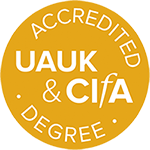Displaying 18 projects
The bioarchaeological characterization of disabled individuals from the past is particularly challenging because it pushes the boundaries of the interpretation of pathologies recognisable on human remains. With my project, namely B-CARED, I will investigate the bioarchaeological approaches for...
Excavations of a Prehistoric and Roman landscape at Bury Farm, Stapleford, Cambridgeshire.
This research employs archaeobotanical and biomolecular methods to reconstruct ancient agropastoral change over the first millennium CE in two microregions, the Aravah valley along the southern border of modern Israel-Jordan and the adjacent Negev Highlands. The region witnessed unprecedented...
This archaeology-led initiative focuses on the East Anglian Fens, an extraordinary landscape where exceptional preservation of organic artefacts and environmental evidence gives unparalleled insights into the last 5,000 years of communities, resources and habitats. The Fens are the richest and most...
The last decades have witnessed marked achievements of STEM in understanding the remains of humans, animals, and plants from the past by analyzing different materials, both inorganic and organic. These developments have opened-up the great potential for increasing our understanding of cultural...
Image: Ancient pastoralist settlement viewed from the air, Amboseli, Kenya. Photo: P. Lane. Mapping Africa's – Endangered Archaeological Sites and Monuments (maeasam.org) project aims to identify and document endangered archaeological heritage sites across Africa using a combination of remote...
The PROCON project explores the role of textile production and consumption in the formation of early states, using the example of Mediterranean Europe during 1000-500 BCE.
The aim of this project is to better understand the health consequences of parasitism in the Roman world. The Romans were responsible for introducing sanitation and hygiene infrastructure to those parts their empire where it did not exist before. Communal latrines for town inhabitants, individual...
The aim of this project will be to investigate the nature and impact of Roman imperialism on the frontiers of North Africa (specifically the Maghreb), especially in considering the role of Roman imperialism on the political economy of the region and its impact on both pre-existing communities and...
Despite a long history of intensive landscape-oriented archaeological research in the Aegean, most primary fieldwork has been concentrated in mainland Greece and a few Aegean islands. By contrast, the eastern side of the Aegean has received far less attention, with local methods and research...
The Promised project forms a network of excellence in Bioarchaeology and Archaeological Materials Science within the Science and Technology in Archaeology and Culture Research Center (STARC) at the Cyprus Institute linked with the advanced research centres in Archaeological Science at KU Leuven and the University of Cambridge.
The Rising from the Depths Network aims to identify ways in which the marine and maritime cultural heritage of Kenya, Tanzania, Mozambique and Madagascar can be used to benefit coastal communities in these countries. Many of these communities are among the poorest in the region and are especially...
A study of the Roman pottery of the Nepi Survey Project in 2007.
Cambridge is home to world-leading researchers across archaeological science, technical art history and heritage science, based at Department of Archaeology, the Fitzwilliam Museum, and the Hamilton Kerr Institute, among others. There are multiple synergies across these institutions in terms of...
Identifying and investigating sites of probable Bronze Age, Iron Age, Roman, and Saxon date in the hinterland of Canterbury.
What does a river do? As anyone who has lived by one knows, rivers structure human worlds in many ways. This project explores the role of Europe’s greatest river in the formation of new societies, in and after the last centuries of the Roman Empire in the West (150–700 AD). The Danube occupied a...
PersianTRAIL is a research project using Geographic Information Systems (GIS), Remote Sensing (RS), and historical-archaeological data to reconstruct the Persian Royal Road (PRR), a key infrastructure of the Achaemenid Empire (6th–4th century BCE). The project examines factors like topography...
The PlaCe network is a high-profile partnership focused on the interdisciplinary study of pre-modern ceramics and plasters. This Innovative Training Network aims at training Early-Stage Researchers to conduct state-of-the-art, science-based research on the technology, use, and provenance of...


